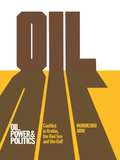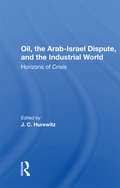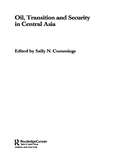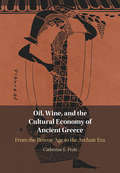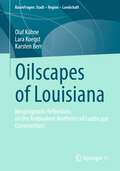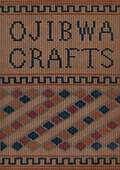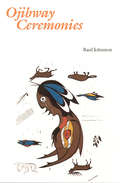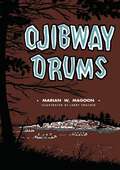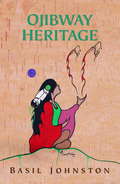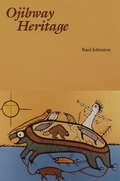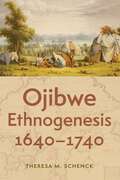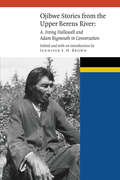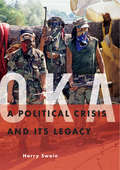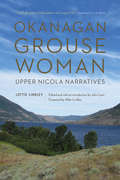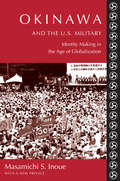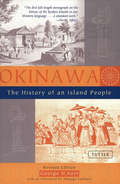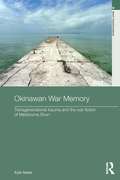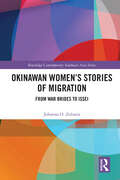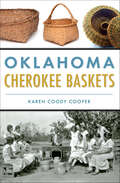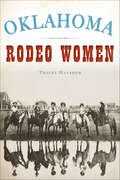- Table View
- List View
Oil, Power and Politics: Conflict of Asian and African Studies, Hebrew University of Jerusalem
by Mordechai AbirThis study of political relations in the Middle East analyzes the reasons behind the instability of the region.
Oil, The Arab-israel Dispute, And The Industrial World: Horizons Of Crisis
by J. C. HurewitzThis book is the product of a multinational project, sponsored by the Middle East Institute of Columbia University in cooperation with the World Peace Foundation (Boston), the Atlantic Institute for International Affairs (Paris), and the Asia-Pacific Association of Japan (Tokyo). It focuses on the principal unresolved issues of the energy crisis, t
Oil, Transition and Security in Central Asia
by Sally CummingsApproaching Central Asia from the perspective of geopolitics, transition, oil and stability, the authors provide a very broad and diverse analysis of the region, examining domestic and international developments since 1991. The book both provides an introduction to the region and presents advanced research on international pipeline projects, political risk and developments after September 11th. The authors draw on a variety of disciplines, including economics, politics, international relations, law and sociology.
Oil, Wine, and the Cultural Economy of Ancient Greece: From the Bronze Age to the Archaic Era
by Catherine E. PrattIn this book, Catherine E. Pratt explores how oil and wine became increasingly entangled in Greek culture, from the Late Bronze Age to the Archaic period. Using ceramic, architectural, and archaeobotanical data, she argues that Bronze Age exchange practices initiated a strong network of dependency between oil and wine production, and the people who produced, exchanged, and used them. After the palatial collapse, these prehistoric connections intensified during the Iron Age and evolved into the large-scale industries of the Classical period. Pratt argues that oil and wine in pre-Classical Greece should be considered 'cultural commodities', products that become indispensable for proper social and economic exchanges well beyond economic advantage. Offering a detailed diachronic account of the changing roles of surplus oil and wine in the economies of pre-classical Greek societies, her book contributes to a broader understanding of the complex interconnections between agriculture, commerce, and culture in the ancient Mediterranean.
Oilscapes of Louisiana: Neopragmatic Reflections on the Ambivalent Aesthetics of Landscape Constructions (RaumFragen: Stadt – Region – Landschaft)
by Olaf Kühne Karsten Berr Lara KoegstOilscapes are to be understood as an aestheticized synthesis of objects of extraction, distribution, processing, and consumption of petroleum and petroleum-derived products. Based on the concept of neopragmatic landscape research, this book addresses questions of the social construction of the relationship between the petrochemical industry and the landscape, as well as individual interpretations and evaluations in this regard. The particular focus is on exploring the possibilities and limits of aesthetic experience of oilscapes as well as the categorizations, interpretations, and evaluations of these aesthetic outcomes. In recourse to the neopragmatic tradition, to the thinking of Richard Rorty, the engagement with ‘sensory induced cognition' is carried out from the stance of irony, directed in particular at the discourse community possessing 'expert special knowledge', with a special focus on methods of representation that are innovative in the context of spatial science. The study area for assessing this approach is Louisiana (United States), which – being spatially quite diverse – has been intensively shaped for more than a century by the activities of the petrochemical industry, as well as its unintended health and ecological side effects.
Ojibwa Crafts
by Carrie A. LyfordIn the first half of the twentieth century, the Ojibwa (Chippewa) people of the western Great Lakes region still retained many of their traditional tribal ways of life, ways of life which included a wealth of ingenious and clever crafts based upon their understanding and use of natural local materials. With few tools but a long history, skilled artisans created the everyday articles needed for shelter, food preparation, clothing, and ceremonials; they also found time to make decorative items for exchange at trading posts or for sale to tourists who passed through their lands.-Print ed.
Ojibway Ceremonies
by Basil JohnstonThe Ojibway Indians were first encountered by the French early in the seventeenth century along the northern shores of Lakes Huron and Superior. By the time Henry Wadsworth Longfellow immortalized them in The Song of Hiawatha, they had dispersed over large areas of Canada and the United States, becoming known as the Chippewas in the latter. A rare and fascinating glimpse of Ojibway culture before its disruption by the Europeans is provided in Ojibway Ceremonies by Basil Johnston, himself an Ojibway who was born on the Parry Island Indian Reserve. Johnston focuses on a young member of the tribe and his development through participation in the many rituals so important to the Ojibway way of life, from the Naming Ceremony and the Vision Quest to the War Path, and from the Marriage Ceremony to the Ritual of the Dead. In the style of a tribal storyteller, Johnston preserves the attitudes and beliefs of forest dwellers and hunters whose lives were vitalized by a sense of the supernatural and of mystery.
Ojibway Drums
by Marian W. MagoonOjibway Drums by Marian W. Magoon is a captivating novel that brings to life the rich traditions, culture, and resilience of the Ojibway people. With poetic prose and heartfelt storytelling, Magoon weaves a tale of identity, connection, and the enduring power of heritage in the face of change.Set in the lush forests and shimmering lakes of the Great Lakes region, the story follows a young Ojibway protagonist as they navigate the challenges of growing up in a world where modern influences and traditional ways of life collide. At the heart of the narrative is the ceremonial drum, a symbol of unity, spiritual connection, and the heartbeat of the Ojibway community. Through its rhythm, the protagonist discovers a deeper understanding of their culture, family, and the values that define their people.Magoon’s storytelling is infused with vivid descriptions of Ojibway customs, legends, and ceremonies, offering readers an authentic glimpse into the community’s way of life. As the protagonist faces personal struggles and larger societal pressures, they embark on a journey of self-discovery and reconciliation, guided by the wisdom of elders and the powerful symbolism of the drum.Ojibway Drums is a celebration of cultural preservation and the strength found in embracing one’s roots. Magoon’s narrative highlights themes of resilience, respect for nature, and the importance of storytelling in passing down traditions from one generation to the next.Perfect for readers of all ages, Ojibway Drums is an evocative and moving tale that will resonate with anyone who values the intersection of heritage, identity, and the timeless stories that connect us all. It’s a tribute to the enduring spirit of the Ojibway people and a reminder of the power of community and tradition.
Ojibway Heritage
by Basil JohnstonRarely accessible beyond the limits of its people, Ojibway mythology is as rich in meaning and mystery, as broad, as deep, and as innately appealing as the mythologies of Greece, Rome, Egypt, and other civilizations. In Ojibway Heritage, Basil Johnston sets forth the broad spectrum of his people's life, legends, and beliefs. Stories to be read, enjoyed, dwelt on, and freely interpreted, their authorship is perhaps most properly attributed to the tribal storytellers who have carried on the oral tradition which Basil Johnston records and preserves in this book.From the Trade Paperback edition.
Ojibway Heritage
by Basil JohnstonRarely accessible to the general public, Ojibway mythology is as rich in meaning, as broad, as deep, and as innately appealing as the mythologies of Greece, Rome, and other Western civilizations. In Ojibway Heritage Basil Johnston introduces his people's ceremonies, rituals, songs, dances, prayers, arid legends. Conveying the sense of wonder and mystery at the heart of the Ojibway experience, Johnston describes the creation of the universe, followed by that of plants and animals and human beings, and the paths taken by the latter. These stories are to be read, enjoyed, and freely interpreted. Their authorship is perhaps most properly attributed to the tribal storytellers who have carried on the oral tradition that Johnston records and preserves in this book.
Ojibwe Ethnogenesis, 1640–1740
by Theresa M. SchenckIn Ojibwe Ethnogenesis, 1640–1740 Theresa M. Schenck (Ojibwe, Huron, and Blackfeet) presents the first scholarly work to untangle the origin, rise, and spread of Ojibwe identity and culture from the mid-seventeenth to mid-eighteenth centuries, as well as the emergence of Ojibwe identity in the early years of French imperial incursions into the Upper Midwest. Schenck traces the names ascribed to the Ojibwe by French officials, traders, missionaries, and settlers in the earliest European records to their presences in French America. Schenck then follows the people themselves and their complex relationships through the centuries. Schenck&’s proficiency in French and her close reading of the sources, many in French, have facilitated a more accurate, traceable, and comprehensive documentary study than achieved by previous generations of scholars. Ojibwe Ethnogenesis, 1640–1740 has thus achieved our fullest understanding to date of Ojibwe roots and culture going back four hundred years.
Ojibwe Stories from the Upper Berens River: A. Irving Hallowell and Adam Bigmouth in Conversation (New Visions in Native American and Indigenous Studies)
by Jennifer S. BrownIn Ojibwe Stories from the Upper Berens River Jennifer S. H. Brown presents the dozens of stories and memories that A. Irving Hallowell recorded from Adam (Samuel) Bigmouth, son of Ochiipwamoshiish (Northern Barred Owl), at Little Grand Rapids in the summers of 1938 and 1940. The stories range widely across the lives of four generations of Anishinaabeg along the Berens River in Manitoba and northwestern Ontario. In an open and wide-ranging conversation, Hallowell discovered that Bigmouth was a vivid storyteller as he talked about the eight decades of his own life and the lives of his father, various relatives, and other persons of the past. Bigmouth related stories about his youth, his intermittent work for the Hudson’s Bay Company, the traditional curing of patients, ancestral memories, encounters with sorcerers, and contests with cannibalistic windigos. The stories also tell of vision-fasting experiences, often fraught gender relations, and hunting and love magic—all in a region not frequented by Indian agents and little visited by missionaries and schoolteachers. With an introduction and rich annotations by Brown, a renowned authority on the Upper Berens Anishinaabeg and Hallowell’s ethnography, Ojibwe Stories from the Upper Berens River is an outstanding primary source for both First Nations history and the oral literature of Canada’s Ojibwe peoples.
Oka
by Harry SwainOn July 11, 1990, tension between white and Mohawk people at Oka, just west of Montreal, took a violent turn. At issue was the town's plan to turn a piece of disputed land in the community of Kanesatake into a golf course. Media footage of rock-throwing white residents and armed, masked Mohawk Warriors facing police across barricades shocked the world and galvanized Aboriginal people across the continent. In August, Quebec Premier Robert Bourassa called for the Canadian army to step in.Harry Swain was deputy minister of Indian Affairs throughout the 78 -day standoff, and his recreation of events is dramatic and opinionated. Swain writes frankly about his own role and offers fascinating profiles of the high-level players on the government's side. Swain offers rare insight into the workings of government in a time of crisis, but he also traces what he calls the 200-year tail of history and shows how the Mohawk experience reflects the collision between European and Aboriginal cultures.Twenty years on, health, social and economic indicators for Aboriginals are still shameful. Identifying current flashpoints for Aboriginal land rights across the country, Swain argues that true reconciliation will not be possible until government commits to meaningful reform.
Okanagan Grouse Woman: Upper Nicola Narratives
by Lottie LindleyPublished through the Recovering Languages and Literacies of the Americas initiative, supported by the Andrew W. Mellon FoundationIn this book of Native American language research and oral traditions, linguist John Lyon collects Salish stories as told by culture-bearer Lottie Lindley, one of the last Okanagan elders whose formative years of language learning were unbroken by the colonizing influence of English. Speaking in the Upper Nicola dialect of Okanagan, a Southern Interior Salish language, Lindley tells the stories that recount and reflect Salish culture, history, and historical consciousness (including names of locales won in battle with other interior peoples), coming-of-age rituals and marriage rites, and tales that attest to the self-understanding of the Salish people within their own history. For each Okanagan Salish story, Lyon and Lindley offer a continuous transcription followed by a collaborative English translation of the story and an interlinear rendition with morphological analysis. The presentation allows students of the dialect, linguists, and those interested in Pacific Northwest and Interior Plateau indigenous oral traditions unencumbered access to the culture, history, and language of the Salish peoples. With few native speakers left in the community, Okanagan Grouse Woman contributes to the preservation, presentation, and—with hope—maintenance and cultivation of a vital indigenous language and the cultural traditions of the Interior Salish peoples.
Okinawa and the U.S. Military: Identity Making in the Age of Globalization
by Masamichi InoueIn 1995, an Okinawan schoolgirl was brutally raped by several U.S. servicemen. The incident triggered a chain of protests by women's groups, teachers' associations, labor unions, reformist political parties, and various grassroots organizations across Okinawa prefecture. Reaction to the crime culminated in a rally attended by some 85,000 people, including business leaders and conservative politicians who had seldom raised their voices against the U.S. military presence.Using this event as a point of reference, Inoue explores how Okinawans began to regard themselves less as a group of uniformly poor and oppressed people and more as a confident, diverse, middle-class citizenry embracing the ideals of democracy, human rights, and women's equality. As this identity of resistance has grown, however, the Japanese government has simultaneously worked to subvert it, pressuring Okinawans to support a continued U.S. presence. Inoue traces these developments as well, revealing the ways in which Tokyo has assisted the United States in implementing a system of governance that continues to expand through the full participation and cooperation of residents.Inoue deftly connects local social concerns with the larger political processes of the Japanese nation and the global strategies of the United States. He critically engages social-movement literature along with postmodern/structural/colonial discourses and popular currents and themes in Okinawan and Japanese studies. Rich in historical and ethnographical detail, this volume is a nuanced portrait of the impact of Japanese colonialism, World War II, and U.S. military bases on the formation of contemporary Okinawan identity.
Okinawa:The History of an Island People
by Mitsugu Sakihara George H. Kerr"The first full-lenght monograph on the history of the Ryukyu Islands in any Western language...a standard work."--Pacific AffairsThis book is the definitive work on Okinawan History and an important scholarly work in the field of Japanese studies.Few people can point to Okinawa on a map, yet this tiny island sitting between China and Japan was and continues to be one of the most crucial Asian nerve centers in all U.S. strategic defense. Ninety percent of all U.S. military forces in Japan are located on Okinawa, one of the Ryukyu Islands, and it was through these troops that the martial art of karate was exported to the U.S. In Okinawa: History of an Island People, noted Eastern affairs specialist George Kerr recounts the fascinating history of the island and its environs, from 1314 A.D. to the late twentieth century. The histories of Japan, Okinawa and the entire Pacific region are crucially intertwined so the study of this fascinating chain of islands is crucial to understanding all of East Asia. First published in 1958, this edition features a new introduction and appendix by Okinawa history scholar Mitsugu Sakihara, making this the most comprehensive resource on the small, vital, and intriguing Okinawa
Okinawa:The History of an Island People
by Mitsugu Sakihara George H. Kerr"The first full-length monograph on the history of the Ryukyu Islands in any Western language...a standard work."--Pacific AffairsThis book is the definitive work on Okinawan History and an important scholarly work in the fields of Japanese studies and Japanese history.Few people can point to Okinawa on a map, yet this tiny island sitting between China and Japan was and continues to be one of the most crucial Asian nerve centers in all U.S. strategic defense. Ninety percent of all U.S. military forces in Japan are located on Okinawa, one of the Ryukyu Islands, and it was through these troops that the martial art of karate was exported to the United States. In Okinawa: History of an Island People, noted Eastern affairs specialist George Kerr recounts the fascinating history of the island and its environs, from 1314 A.D. to the late twentieth century. The histories of Japan, Okinawa and the entire Pacific region are crucially intertwined so the study of this fascinating chain of islands is crucial to understanding all of East Asia.
Okinawan War Memory: Transgenerational Trauma and the War Fiction of Medoruma Shun
by Kyle IkedaAs one of Okinawa's most insightful writers and social critics, Medoruma Shun has highlighted the problems and limits of conventional representation of the Battle of Okinawa, raised new questions and concerns about the nature of Okinawan war memory, and expanded the possibilities of representing war through his groundbreaking and prize-winning fiction, editorials, essays, and speaking engagements. Yet, his writing has not been analyzed in regard to how his experience and identity as the child of two survivors of the Battle of Okinawa have powerfully shaped his understanding of the war and his literary craft. This book examines Okinawan war memory through the lens of Medoruma’s war fiction, and pays particular attention to the issues of second-generation war survivorship and transgenerational trauma. It explores how his texts contribute to knowledge about the war and its ongoing effects — on survivors, their offspring, and the larger community — in different ways from that of other modes of representation, such as survivor testimony, historical narrative, and realistic fiction. These dominant means of memory making have played a major role in shaping the various discourses about the war and the Battle of Okinawa, yet these forms of public memory and knowledge often exclude or avoid more personal, emotional, and traumatic experiences. Indeed, Ikeda’s analysis sheds light on the nature of trauma on survivors and their children who continue to inhabit sites of the traumatic past, and in turn makes an important contribution to studies on trauma and second-generation survivor experiences. This book will be of huge interest to students and scholars of Asian literature, Japanese literature, Japanese history, war memory and Okinawa.
Okinawan Women's Stories of Migration: From War Brides to Issei (Routledge Contemporary Southeast Asia Series)
by Johanna ZuluetaThe phenomenon of “war brides” from Japan moving to the West has been quite widely discussed, but this book tells the stories of women whose lives followed a rather different path after they married foreign occupiers. During Okinawa’s Occupation by the Allies from 1945 to 1972, many Okinawan women met and had relationships with non-Western men who were stationed in Okinawa as soldiers and base employees. Most of these men were from the Philippines. Zulueta explores the journeys of these women to their husbands’ homeland, their acculturation to their adopted land, and their return to their native Okinawa in their late adult years. Utilizing a life-course approach, she examines how these women crafted their own identities as first-generation migrants or “Issei” in both the country of migration and their natal homeland, their re-integration to Okinawan society, and the role of religion in this regard, as well as their thoughts on end-of-life as returnees. This book will be of interest to scholars looking at gender and migration, cross-cultural marriages, ageing and migration, as well as those interested in East Asia, particularly Japan/Okinawa.
Oklahoma Black Cherokees (American Heritage)
by Karen Coody Cooper and Ty WilsonOver the generations, Cherokee citizens became a conglomerate people. Early in the nineteenth century, tribal leaders adapted their government to mirror the new American model. While accommodating institutional slavery of black people, they abandoned the Cherokee matrilineal clan structure that once determined their citizenship. The 1851 census revealed a total population nearing 18,000, which included 1,844 slaves and 64 free blacks. What it means to be Cherokee has continued to evolve over the past century, yet the histories assembled here by Ty Wilson, Karen Coody Cooper and other contributing authors reveal a meaningful story of identity and survival.
Oklahoma Cherokee Baskets (American Heritage)
by Karen Coody CooperThe forced relocation of fifteen thousand Cherokee to Oklahoma nearly two centuries ago left them in a foreign landscape. Coping with loss and new economic challenges, the Cherokee united under a new constitution and exploited the Victorian affinity for decorative crafts. Cherokee women had always created patterned baskets for everyday use and trade, and soon their practical work became lucrative items of beauty. Adapting the tradition to the new land, the industrious weavers transformed Oklahoma's vast natural resources into art that aided their survival. The Civil War found the Cherokee again in jeopardy, but resilient, they persevered and still thrive today. Author and Cherokee citizen Karen Coody Cooper presents the story of this beautiful legacy.
Oklahoma Rodeo Women (American Heritage)
by Tracey HanshewOklahoma's central location and ranching tradition gave it a unique connection to the rodeo industry as it grew from a local pastime to an internationally popular sport. From the very beginning, Oklahoma cowgirls played a significant role in developing the institution and the businesses that grew up in its shadow. Lucille Mulhall's pioneering roping carved out a place for women in the actual competition, while Mildred Chrisman's promotional efforts kept rodeo chutes open during the Great Depression. Modern ranchers like Terry Stuart produced the quarter horses sought by professional athletes around the world. From Guymon to Pawhuska and from stock contractors to rodeo clowns, Tracey Hanshew follows the trail that Oklahoma women blazed across this rough-and-tumble sport.
Oklahomo: Lessons in Unqueering America (SUNY series in Queer Politics and Cultures)
by Carol MasonBy exploring the scandal-filled lives of four Oklahomans, this book demonstrates how unqueering operates in a conservative American context. Carol Mason weaves a story about how homogenizing, antigay ideas evolve from generation to generation so that they achieve particular economic, imperial, racial, and gendered goals. Using engaging and accessible commentary on antigay crusaders (Sally Kern and Anita Bryant) and two queer teachers dismissed from their positions (Billy James Hargis and Bruce Goff), Mason illustrates how the lives of these figures represent paradigmatic moments in conservative confrontations with queers and help us to understand the conflation of terrorism with homosexuality, which dates back to the McCarthy era.
